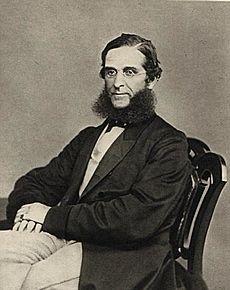John Evans (archaeologist) facts for kids
Quick facts for kids
Sir John Evans
|
|
|---|---|

John Evans (archaeologist)
|
|
| Born | 17 November 1823 Burnham, Buckinghamshire
|
| Died | 31 May 1908 (aged 84) |
| Nationality | English |
| Awards | Lyell Medal (1880) |
| Scientific career | |
| Fields | Archaeology Geology |
| Influenced | Arthur Evans |
Sir John Evans (born November 17, 1823 – died May 31, 1908) was a very important English scientist. He was an expert in archaeology, which is the study of old things people left behind, and geology, which is the study of Earth's rocks and history. He helped us understand more about ancient times in Britain. He was also a numismatist, meaning he studied coins and medals.
About John Evans
John Evans was born in Buckinghamshire, England. When he was 17, he started working for a paper company called John Dickinson & Co. Ltd. This company was started by his uncle, John Dickinson. In 1850, John Evans became a partner in the company. He worked there until 1885.
Even though he managed a business, John Evans was also a brilliant scholar. He was a leader in many important groups:
- The Society of Antiquaries, from 1885 to 1892. This group studies ancient objects and history.
- The Royal Numismatic Society, from 1874 until he died. This group focuses on coins and medals.
- The Geological Society of London, from 1874 to 1876. This group studies Earth's geology.
- The Anthropological Institute, from 1877 to 1879. This group studies human societies and cultures.
- The British Association for the Advancement of Science, from 1897 to 1898. This group promotes science.
In 1864, he became a Fellow of the Royal Society, which is a very high honor for scientists. He also served as the treasurer for the Royal Society for 20 years.
As the President of the Society of Antiquaries, he became a trustee of the British Museum. This meant he helped manage the museum. He later became a permanent trustee. Many universities gave him special honorary degrees. In 1892, he was made a Knight Commander of the Order of the Bath (KCB) by the Queen.
John Evans had a huge collection of ancient objects. Most of these were given to the Ashmolean Museum in Oxford by his son, Arthur. Some amazing items from his collection include the "Ixworth Cross" and the "Tostock Buckle", which are Anglo-Saxon jewels. His large library of books was given to the Bodleian Library. He also helped dig up Iron Age items in Austria, which are now in the British Museum.
He lived in Berkhamsted, England, where he passed away in 1908.
His Important Books
John Evans wrote three famous books that were very important in their fields:
- The Coins of the Ancient Britons (1864): This book was all about the old coins used by people in Britain long ago.
- The Ancient Stone Implements, Weapons and Ornaments of Great Britain (1872): This book described ancient tools, weapons, and decorations made of stone found in Britain.
- The Ancient Bronze Implements, Weapons and Ornaments of Great Britain and Ireland (1881): This book focused on ancient tools, weapons, and decorations made of bronze found in Britain and Ireland.
He also wrote many shorter articles about archaeology and geology. One important set of articles was about "Flint Implements in the Drift," which he shared in 1860 and 1862. These articles helped show that humans had lived in Britain much longer than people thought.
His Family
John Evans was married three times and had six children. His first wife was Harriet Ann Dickinson. They had five children together:
- Sir Arthur John Evans (1851–1941): He became a famous archaeologist. He was the curator of the Ashmolean Museum and discovered the ancient Minoan civilization on the island of Crete.
- Lewis Evans (1853–1930): He continued the family business. He also collected many old scientific tools. These tools became the main collection for the Museum of the History of Science, Oxford.
- (Philip) Norman Evans (1854–1893): He became a chemist.
- Alice Evans (1856–1882): She married William Minet but sadly died young.
- Harriet Ann Evans (1857–1938): She married into the Longman family, who were famous publishers.
Harriet, his first wife, died in 1858. John then married his cousin, Frances Phelps. She passed away in 1890.
In 1892, John married Maria Millington Lathbury. They had one daughter:
- Dame Joan Evans: She became a well-known art historian. She studied French and English medieval art. Her book Time and Chance: The Story of Arthur Evans and His Forebears (1943) tells a lot about her father's life.


